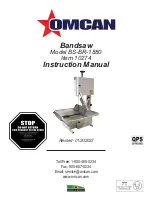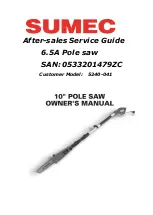
7.1.2 Selecting the Speed:
This description can of course only give a guideline for the option to be
taken. As in the previous section, you have to do a little “experiment-
ing” to find the optimum result. The right speed also depends on the
blade used, the workpiece material, feed etc. of course.
7.1.3 Possible Causes of Broken Saw Blades:
The saw blade can break for the following reasons:
• blade tension too high or too low
• mechanical overloading of the blade by moving too quickly
• bending or twisting of the blade when turning the workpiece too
quickly to cut curves
• when the wear limit of the saw blade is reached
• when the screws are tightened with saw blades with pin ends
7.2 Sawing (Fig. 10)
Please hold the workpiece on the saw table as shown in fig. 10. Adapt
the feeding to the material, the saw blade and the thickness of the
workpiece! Hard materials, fine saw blades and thicker workpieces do
not “stand” as must thrust as softer materials, coarser saw blades and
thin workpieces.
Try out results at different speeds.
N.B.:
Safe and accurate work is only possible with careful fastening!
The scroll saw is primarily a machine for sawing curves. For good
results, please note the following points:
For your own safety please:
• Only use perfect saw blades!
• Always pull out the mains plug for maintenance and cleaning.
• Do not leave the device unattended.
• Always make sure that the saw blade guard is in the operating posi-
tion as shown in fig. 10!
1. Press the workpiece against the worktop when sawing; guide gently
with little force; more pressure on the worktop, less pressure on the
saw blade. Caution: The saw does not cut the workpiece on its own.
You have to move the workpiece into the saw blade.
2. Move the workpiece into the saw blade slowly especially if the blade
is very thin and the teeth very fine or the workpiece is very thick.
The best results are achieved with a wood thickness of less than 25
mm.
7.2.1 Inside Cuts (Fig. 11)
Caution:
Always pull out the mains plug before loosening the saw blade!
If you want to make inside cuts when working with your scroll saw,
there are different ways to thread the saw blade through the opening in
the workpiece.
If the inside cuts are big enough, the saw blade can be inserted with
the sliding block, i.e. in the assembled state. However, finer inside cuts
are also possible: To do this, the sliding block is clamped in the top
holder, the saw blade loosened, inserted into the workpiece and
reclamped. When using saw blades with pin ends, these must be sim-
ply attached and detached after loosening the saw blade tension.
1. Drill a hole in the part of the workpiece to be cut out 1.
2. Loosen the saw blade tension by turning the knob 2.
3. Detach the saw blade with the sliding block or the pin end from the
top saw blade holder 3 or
4. clamp the sliding block with the knurled screw 4, loosen the nut 5
and remove the saw blade.
5. Push the saw blade through the hole in the workpiece and reattach
the sliding block or pin end or insert the saw blade in the sliding
block and reclamp with the nut 5. Loosen knurled screw 4!
Caution:
Please note that the knurled screw 4 must alsways be loosened in
operation! The sliding block may not be clamped during operation but
must swing freely!
6. Set the saw blade tension correctly with the knob 2.
7. Cut out the opening and remove the workpiece after detaching the
saw blade again.
A tip:
If you drill the hole so that it does not touch the later inside contour,
you can have the sawing line “run in” to the contour to be sawn out tan-
gentially. This gives a nice even sawing edge.
If necessary, the lower of the recesses in the sawing table (fig. 1, item
19) can be used for fixing the sliding block if it is necessary to loosen
the nut of the sliding block to remove the blade.
7.2.2 Mitre Cuts (Fig. 2b)
7.2.2.1 Setting the Mitre Angle
For mitre cuts, the table is simply tilted by the desired angle. This can
be done quickly and easily with the angle adjustment of your DS 460.
1. Loosen the clamping screw 2.
2. Move the lock lever 3 down and tilt the saw table 1 to the desired
angle.
3. Snap the lock lever into the appropriate recess of the angle scale 4
on the saw table.
4. Retighten the clamping screw 2.
Caution!
Please press the workpiece very firmly against the table to saw a mitre
cut.
7.2.2.2 Fine Setting (Fig. 2b)
Please note:
The recesses in the angle scale are designed so that the most com-
mon mitre cuts can be selected quickly. Any intermediate setting can
also be made of course. To do this, simply turn the knurled screw 5
when the lever is in a detent position. Please note: The clamping screw
2 can be left tight to make the setting!
7.2.2.3 Setting the saw blade stroke (fig. 12 a and 12 b)
The factory-set saw blade stroke of 18 mm represents the optimum for
most applications and usually does not need to be changed. In rare
cases, certain working conditions do not permit satisfactory working
results, for example, if the saw blade speed is too high even at a low
number of strokes (e.g., if sawing plastic and the material melts and
welds back together). In this case, the DS 460 makes it possible to
minimise the stroke which reduces the cutting speed.
1. Unscrew both screws from suction connection 8 and remove the
suction connection
2. Unscrew both screws 1 and detach cover plate 4
3. Use the included Allen screw to unscrew screw 6 from the eccentric
7.
4. Screw in screw 6 to the second thread in the eccentric.
5. Screw plate 4 together with screw 3
6. Screw plate 2 together with both screws 1
7. Refasten the suction connection
Speed
Material
900 strokes/min
Steel, brass, non-ferrous metals, GRP,
plastics
1,400 strokes/min
aluminium, wood, polystyrene, rubber,
leather, cork
16
Содержание DS 460
Страница 1: ...DS 460 Manual ...
Страница 10: ...78 Spare Parts List PROXXON DS460 ET Nr Description ET Nr Description ...






























